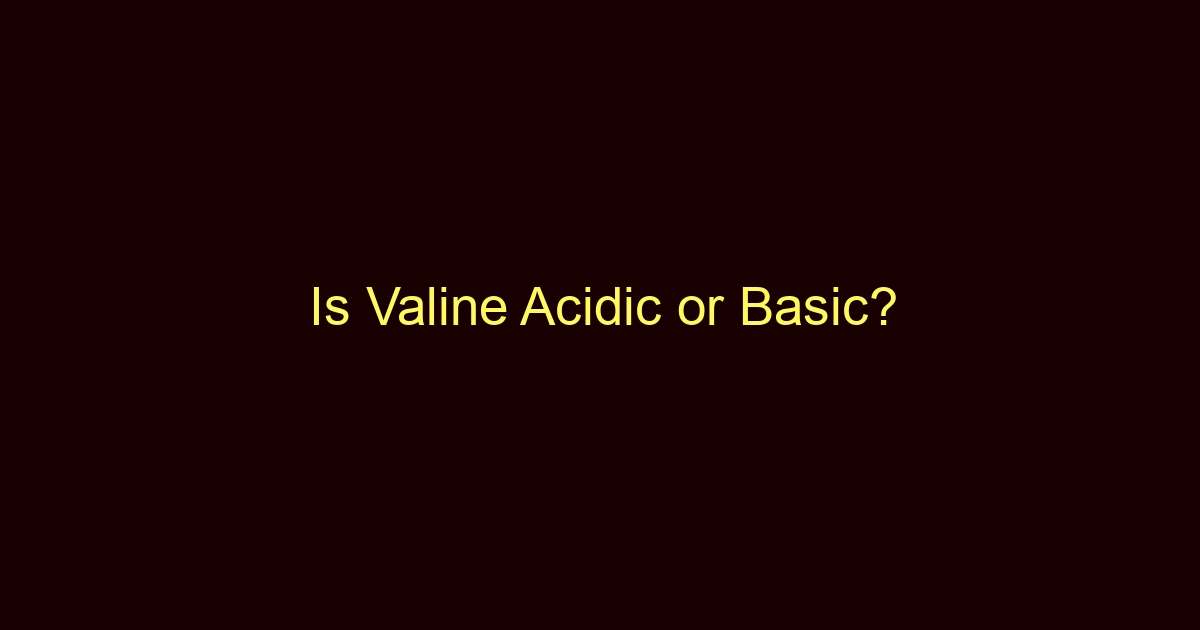Valine is an amino acid that is considered neutral but leans towards being hydrophobic. In the context of its side chain, it is neither acidic nor basic. It has a pKa value that typically hovers around 2.32.
Valine is one of the 20 standard amino acids used in the biosynthesis of proteins. It’s classified under the branched-chain amino acids (BCAAs), along with leucine and isoleucine. A lot of people wonder whether it’s acidic or basic because this classification could have implications for health, especially when considering dietary needs and metabolic processes. Valine is a complex molecule, and its acidic or basic nature cannot be ascertained by a simple yes or no answer. So, let’s dive into this topic a bit more.
Is Valine Acidic?
No, Valine is not acidic.
Understanding the nature of amino acids like valine requires a deep dive into biochemistry. Typically, amino acids can be classified as acidic, basic, or neutral based on the nature of their side chain groups. Valine’s side chain is an isopropyl group, which is hydrophobic and leans towards being neutral rather than acidic. This characteristic has a direct bearing on how valine interacts within a protein structure, often finding itself buried within the hydrophobic core of the protein.
Now, what does this mean for you? Well, in a physiological context, the neutrality of valine means it does not significantly affect the body’s overall pH balance. This makes it easy for valine to work in conjunction with other amino acids to carry out metabolic processes that are essential for maintaining good health.
Furthermore, valine’s lack of acidity allows it to participate in various biochemical reactions without introducing additional protons (H+ ions) that could otherwise affect a reaction’s acidity. This is crucial for metabolic processes such as protein synthesis and energy production.
Is Valine Basic?
No, Valine is not basic.
When talking about the basic nature of amino acids, we often refer to the properties of the side chain. Valine has a side chain that is hydrophobic, which means it does not have an affinity for water and is generally unreactive. It does not contain functional groups that could accept or donate protons, a key feature of bases.
The biochemical consequences of valine not being basic are similar to its not being acidic. It continues to serve as a neutral component in protein structures, usually finding itself well-suited for the internal regions of proteins where hydrophobic interactions dominate.
Moreover, valine’s neutrality is particularly important in enzymatic reactions. Being neutral, it doesn’t skew the pH levels and therefore does not interfere with the enzyme’s active site, which could otherwise lead to a decrease in the enzyme’s efficiency.
pH Values of Valine:
The pH value is a measure of acidity or alkalinity. The pKa value for valine is around 2.32 for the carboxyl group and 9.62 for the amino group. The pKa for its side chain is not applicable since it does not have an ionizable group. These pKa values suggest that valine is most stable in a slightly acidic environment but is overall neutral.
Final Thoughts:
Valine is a fascinating amino acid with roles that go beyond simple categorizations of being acidic or basic. Its side chain, an isopropyl group, is neutral and hydrophobic, which makes valine an important component in the internal structure of proteins. It doesn’t significantly influence the pH balance of the human body, serving instead as a critical element for metabolic processes.
Understanding the nature of valine not only sheds light on its role in biochemistry but also clarifies its role in dietary and health contexts. The fact that it is neither acidic nor basic means that it maintains a level of neutrality that makes it versatile in biological functions. This feature sets the stage for valine to participate in a wide array of physiological processes, from muscle building to immune function, without altering the body’s internal pH.

